Do you ever wish you had a crystal ball when it came to the future of your business’ finances?
Do you wish you had something to answer questions like:
“Can I afford to hire a VA, or staff so I can “clone myself” and begin to step out of doing it all?”
“When will I have enough money to pull the trigger on that expensive new piece of equipment?”
”When can I pay myself?”
These are all questions that I hear often from both new clients and small business owners. If this is you as well, you aren’t alone! So read on to learn how to answer these questions.
While I don’t exactly have a crystal ball – I do have the next best thing:
Let me introduce you to Cash Flow Forecasting!
WHAT IS IT?
Cash Flow Forecasting is a way of using your past and current financial history to estimate the future cash flow in your business.
You can forecast any range of dates, from short-term 30-day forecasts to longer-term 1 or 2-year forecasts. (Keep in mind – shorter forecasts are more reliable than long-term ones!)
WHAT CAN IT DO FOR YOU?
Cash Flow Forecasting allows you to answer those questions I shared above with a high degree of confidence. Because the method is based on where you have been and where you are, it allows you to create solid, realistic plans for your business (a major step many businesses skip.)
Why does it work? Because the numbers don’t lie. They either add up or they don’t.
While Cash Flow Forecasting is not perfect (because outside forces like global pandemics and changes in the market will interfere,) the good news is that it can and should be updated as needed based on your changing plans. Cash Flow Forecasting remains the best way to plan your future. The process I will share below is the same one that Fortune 500 companies and successful companies in general use regularly.
HOW DOES IT WORK?
Here is an overview of the process:
Step 1: Get your finances up to date – After all, how you can predict the future if you don’t understand the present or past?
Step 2: Run financial reports – Specifically, your cash flow report and your P+L report. Make sure you include at least a full year of business data!
Step 3: Analyze the money coming in – Look for patterns in the past, and apply them to the future. Will you have the same clients, and projects, for the foreseeable future? Will you sell assets (vehicles, equipment, etc.), take out loans, or receive grants? Will you launch any new products or begin working on any new contracts?
Step 4: Analyze the money going out – Again, look for patterns in the past, and apply them to the future. Are your regular expenses going to stay the same – or increase? Do you have any large one-time expenses to account for (like equipment purchases, training/courses, memberships, etc?)
Step 5: Forecast away! – Now, take everything you learned, and project it out over the next 1, 6, or 12 months! You’ll have a solid foundation of data (almost as good as a crystal ball) to answer your future planning and strategy questions.
*Sidenote: this process can also help you spot and solve problems in the present, like high expenses or a negative cash flow!
We have a more comprehensive process we call the Profitability Roadmap in our firm. If you need help navigating your business’s future profitability, we can help. As a business solutions expert, I have helped dozens of businesses untangle complex issues and clarify a path to greater profitability. Let’s schedule a Discovery Session.
Want to learn more profitable strategies for your business? Check out my free guide 5 Things You Must Do If you Want To Increase Your Profits.

